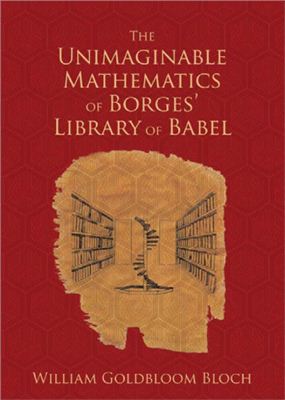"The Library of Babel" is arguably Jorge Luis Borges' best known
story-memorialized along with Borges on an Argentine postage stamp.
Now, in The Unimaginable Mathematics of Borges' Library of Babel,
William Goldbloom Bloch takes readers on a fascinating tour of the
mathematical ideas hidden within one of the classic works of mode
literature.
Written in the vein of Douglas R. Hofstadter's Pulitzer Prize-winning G?del, Escher, Bach, this original and imaginative book sheds light on one of Borges' most complex, richly layered works. Bloch begins each chapter with a mathematical idea-combinatorics, topology, geometry, information theory-followed by examples and illustrations that put flesh on the theoretical bones. In this way, he provides many fascinating insights into Borges' Library. He explains, for instance, a straightforward way to calculate how many books are in the Library-an easily notated but literally unimaginable number-and also shows that, if each book were the size of a grain of sand, the entire universe could only hold a fraction of the books in the Library. Indeed, if each book were the size of a proton, our universe would still not be big enough to hold anywhere near all the books.
Given Borges' well-known affection for mathematics, this exploration of the story through the eyes of a humanistic mathematician makes a unique and important contribution to the body of Borgesian criticism. Bloch not only illuminates one of the great short stories of mode literature but also exposes the reader-including those more inclined to the literary world-to many intriguing and entrancing mathematical ideas.
Contents.
Acknowledgments.
Preface.
Introduction.
The Library of Babel.
Chapter 1 Combinatorics: Contemplating Variations of the 23 Letters.
Chapter 2 Information Theory: Cataloging the Collection.
Chapter 3 Real Analysis: The Book of Sand.
Chapter 4 Topology and Cosmology: The Universe (Which Others Call the Library).
Chapter 5 Geometry and Graph Theory: Ambiguity and Access.
Chapter 6 More Combinatorics: Disorderings into Order.
Chapter 7 A Homomorphism: Structure into Meaning.
Chapter 8 Critical Points.
Chapter 9 Openings.
Appendix—Dissecting the 3-Sphere.
Notations.
Notes.
Glossary.
Annotated SuggestedReadings.
Bibliography.
Index.
ISBN-10: 0195334574[i][/i].
Written in the vein of Douglas R. Hofstadter's Pulitzer Prize-winning G?del, Escher, Bach, this original and imaginative book sheds light on one of Borges' most complex, richly layered works. Bloch begins each chapter with a mathematical idea-combinatorics, topology, geometry, information theory-followed by examples and illustrations that put flesh on the theoretical bones. In this way, he provides many fascinating insights into Borges' Library. He explains, for instance, a straightforward way to calculate how many books are in the Library-an easily notated but literally unimaginable number-and also shows that, if each book were the size of a grain of sand, the entire universe could only hold a fraction of the books in the Library. Indeed, if each book were the size of a proton, our universe would still not be big enough to hold anywhere near all the books.
Given Borges' well-known affection for mathematics, this exploration of the story through the eyes of a humanistic mathematician makes a unique and important contribution to the body of Borgesian criticism. Bloch not only illuminates one of the great short stories of mode literature but also exposes the reader-including those more inclined to the literary world-to many intriguing and entrancing mathematical ideas.
Contents.
Acknowledgments.
Preface.
Introduction.
The Library of Babel.
Chapter 1 Combinatorics: Contemplating Variations of the 23 Letters.
Chapter 2 Information Theory: Cataloging the Collection.
Chapter 3 Real Analysis: The Book of Sand.
Chapter 4 Topology and Cosmology: The Universe (Which Others Call the Library).
Chapter 5 Geometry and Graph Theory: Ambiguity and Access.
Chapter 6 More Combinatorics: Disorderings into Order.
Chapter 7 A Homomorphism: Structure into Meaning.
Chapter 8 Critical Points.
Chapter 9 Openings.
Appendix—Dissecting the 3-Sphere.
Notations.
Notes.
Glossary.
Annotated SuggestedReadings.
Bibliography.
Index.
ISBN-10: 0195334574[i][/i].

